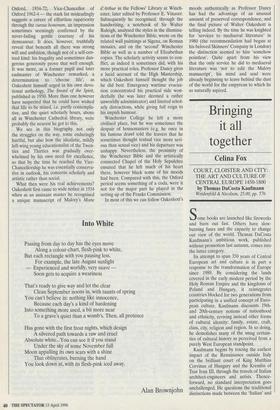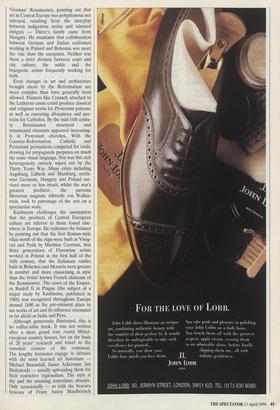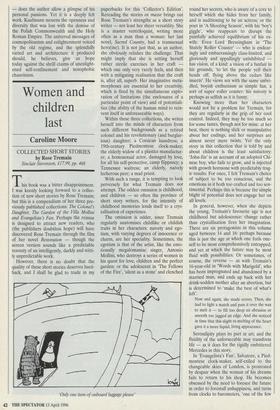Bringing it all together
Celina Fox
COURT, CLOISTER AND CITY: THE ART AND CULTURE OF CENTRAL EUROPE 1450-1800 by Thomas DaCosta Kaufmann Weidenfeld & Nicolson, 25.00, pp. 576 Some books are launched like fireworks and burn out fast. Others have slow- burning fuses and the capacity to change our view of the world. Thomas DaCosta Kaufmann's ambitious work, published without promotion last autumn, comes into the latter category.
Its attempt to span 350 years of Central European art and culture is in part a response to the transformation of Europe since 1989. By considering the lands covered in the early modern period by the Holy Roman Empire and the kingdoms of Poland and Hungary, it reintegrates countries blocked for two generations from participating in a unified concept of Euro- pean culture. Kaufmann discounts 19th- and 20th-century notions of nationhood and ethnicity, reviving instead other forms of cultural identity: family, estate, craft, class, city, religion and region. In so doing, he demolishes many of the smug certain- ties of cultural history as perceived from a purely West European standpoint.
Kaufmann begins by tracing the earliest impact of the Renaissance outside Italy on the brilliant court of King Matthias Corvinus of Hungary and the Kremlin of Tsar Ivan III, through the travels of Italian architect-engineers and artists. Thence- forward, no standard interpretation goes unchallenged. He questions the traditional distinctions made between the 'Italian' and `German' Renaissance, pointing out that art in Central Europe was polyphonous not univocal, resulting from the interplay between indigenous artists and talented émigrés — Diirer's family came from Hungary. He maintains that collaboration between German and Italian craftsmen working in Poland and Bohemia was more the rule than the exception. Neither was there a strict division between court and city culture, the noble and the bourgeois, artists frequently working for both.
Even changes in art and architecture brought about by the Reformation are more complex than have generally been allowed. Painters like Cranach attached to the Lutheran cause could produce classical and religious works for Protestant patrons, as well as executing altarpieces and por- traits for Catholics. By the mid-16th centu- ry Renaissance structural and ornamental elements appeared increasing- ly in Protestant churches. With the Counter-Reformation, Catholic and Protestant persuasions competed for souls, drawing for propaganda purposes on much the same visual language. Nor was this rich heterogeneity entirely wiped out by the Thirty Years War. Many cities including Augsburg, Lubeck and Hamburg, north- west Germany, Hungary and Poland sur- vived more or less intact, whilst the war's greatest profiteer, the parvenu Moravian magnate Albrecht von Wallen- stein, took to patronage of 'the arts on a spectacular scale.
Kaufmann challenges the assumption that the products of Central European culture are inferior to those found else- where in Europe. He redresses the balance by pointing out that the first Roman-style villas north of the Alps were built at Viseg- rad and Nye( by Matthias Corvinus, that three generations of Florentine artists worked in Poland in the first half of the 16th century, that the Italianate castles built in Bohemia and Moravia were greater in number and more classicising in style than the better known French châteaux of the Renaissance. The court of the Emper- or Rudolf II in Prague (the subject of a major study by Kaufmann, published in 1988) was recognised throughout Europe around 1600 as the pre-eminent place to see works of art and its influence resonated as far afield as India and Peru.
Although generously illustrated, this is no coffee-table book. It was not written after a short grand tour round Mittel- european country houses, but on the basis of 20 years' research and travel to the remotest corners of the continent. The lengthy footnotes engage in debates with the most learned art historians Michael Baxandall, James Ackerman, Jan Biolostocki — usually upbraiding them for their restrictive regionalism. The style is dry and the meaning sometimes obscure. Only occasionally — as with the bravura frescoes of Franz Anton Maulbertsch — does the author allow a glimpse of his personal passions. Yet it is a deeply felt work. Kaufmann mourns the openness and diversity that was lost with the demise of the Polish Commonwealth and the Holy Roman Empire. The universal messages of cosmopolitanism and enlightenment voiced by the old regime, and the splendidly varied art and architecture it produced should, he believes, give us hope today against the shrill claims of unenlight- ened self-confinement and xenophobic chauvinism.




































































 Previous page
Previous page